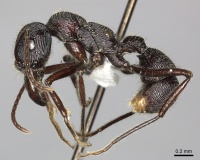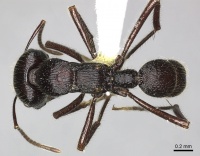Poneracantha banksi
| Poneracantha banksi | |
|---|---|

| |
| Scientific classification | |
| Kingdom: | Animalia |
| Phylum: | Arthropoda |
| Class: | Insecta |
| Order: | Hymenoptera |
| Family: | Formicidae |
| Subfamily: | Ectatomminae |
| Tribe: | Ectatommini |
| Genus: | Poneracantha |
| Species: | P. banksi |
| Binomial name | |
| Poneracantha banksi (Wheeler, W.M., 1930) | |
Found in rotten logs in lowland rain forest, this species is a specialist millipede predator. (Lattke 1995)
Identification
Rarely collected. Finely costulate; head broad with longitudinally striated scapes; mesometanotal suture not deeply impressed, but distinct. It lacks the long, fine mandibular sulcus present in Poneracantha laticephala. (Lattke 1995)
Keys including this Species
Distribution
Latitudinal Distribution Pattern
Latitudinal Range: 10.35° to -2.6914°.
| North Temperate |
North Subtropical |
Tropical | South Subtropical |
South Temperate |
- Source: AntMaps
Distribution based on Regional Taxon Lists
Neotropical Region: Costa Rica, Ecuador, Panama (type locality).
Distribution based on AntMaps
Distribution based on AntWeb specimens
Check data from AntWeb
Countries Occupied
| Number of countries occupied by this species based on AntWiki Regional Taxon Lists. In general, fewer countries occupied indicates a narrower range, while more countries indicates a more widespread species. |

|
Estimated Abundance
| Relative abundance based on number of AntMaps records per species (this species within the purple bar). Fewer records (to the left) indicates a less abundant/encountered species while more records (to the right) indicates more abundant/encountered species. |

|
Biology
Castes
Nomenclature
The following information is derived from Barry Bolton's Online Catalogue of the Ants of the World.
- banksi. Emeryella (Barbourella) banksi Wheeler, W.M. 1930f: 10, fig. 1 (q.) PANAMA.
- Type-material: holotype queen.
- Type-locality: Panama: Barro Colorado I., nr Tropical Laboratory, 24.vii.1924 (N. Banks).
- Type-depository: MCZC.
- Combination in Gnamptogenys: Brown, 1958g: 227;
- combination in Poneracantha: Camacho, Franco, Branstetter, et al. 2022: 11.
- Status as species: Brown, 1958g: 227; Kempf, 1972a: 112; Bolton, 1995b: 208; Lattke, 1995: 158; Lattke, et al. 2004: 342; Lattke, et al. 2007: 261 (in key); Lattke, et al. 2008: 81; Feitosa & Prada-Achiardi, 2019: 671; Camacho, et al. 2020: 459 (in key); Camacho, Franco, Branstetter, et al. 2022: 11.
- Distribution: Colombia, Costa Rica, Ecuador, Nicaragua, Panama.
Unless otherwise noted the text for the remainder of this section is reported from the publication that includes the original description.
Description
Queen
(dealated). Length nearly 8 mm.
Head subrectangular, distinctly broader than long, but not as broad as in Gnamptogenys schmitti, only slightly broader in front than behind, the posterior border feebly and broadly concave, the sides nearly straight, with the eyes at the middle. The latter rather small for a female, moderately convex, broadly elliptical. Ocelli very small and close together. Clypeus short, vertical, rounded behind; its anterior border straight and transverse in the middle, bluntly dentate and sinuate on each side. Mandibles shaped as in G. schmitti, but much shorter and less narrowed toward their tips, the median tooth broad and triangular, the apical denticles more distinct. Antennal scapes curved at the base, their tips reaching beyond the posterior corners of the head to a distance equal to their greatest diameter; funicular joints 1 and 2 subequal, twice as long as broad, 3-10 shorter, about one and one half times as long as broad, terminal joint slightly longer than the two preceding joints together. Thorax twice as long as broad, broader in front than behind, with straight sides. Pronotum narrower than the head, with broadly rounded humeri; mesonoturn small, subtriangular, the base of the triangle broadly rounded, the apex extending forward as a blunt point embraced by the pronotum. Scutellum small and rather fiat. Mesosternum with a distinct, acute denticle just in front of the insertion of the middle coxa. This denticle is also present in G. schmitti. Epinotum higher than long, its base feebly convex, about twice as broad as long and separated from the somewhat longer, distinctly concave declivity by a distinct transverse ridge connecting the two teeth but not interrupting the sculpture. The teeth are small, slightly longer than broad, very blunt, directed backward and outward. Petiole from above as broad in front as behind, with nearly straight sides, convex and rounded behind; in profile it is shaped much as in G. schmitti, being without a peduncle and with the dorsal surface of the node convex and gradually rising and then rather abruptly but roundly trunctated near the posterior border of the segment. The ventral surface of the petiole is feebly concave, with a strong, translucent tooth at the anterior end, directed downward and forward. Postpetiole and gaster very small, together slightly smaller than the thorax, shaped as in G. schmitti; the postpetiole as long as broad, campanulate, with a strong, transverse, antero-ventral projection; the first gastric segment longer than broad, directed downward and somewhat forward at its posterior end, which is constricted and encloses the remaining very small, short, telescoped terminal segments. Sting small and slender. Hind coxae with a prominent blunt tooth on the dorsal surface near the base. Tarsal claws slender and dentate in the middle as in G. schmitti.
Shining throughout, the scapes and legs somewhat more so than the body. Mandibles eoarsely, longitudinally striate, with large elongate punctures between the striae; clypeus, frontal area and antennal foveae rather regularly longitudinally rugose; head coarsely rugose, irregularly and vermiculately behind, somewhat more longitudinally on the front. The rugae are rounded, the spaces between them coarsely foveolate on the vertex and posterior corners, more indistinctly reticulate anteriorly; occiput with a few coarse subtransverse rugae. Anterior impressed portion of pronotum transversely and irregularly rugulose; remainder of pronotum, the mesonotum and scutellum longitudinally and rather regularly subcostate, or coarsely rugose, with coarse elongate, foveolate interrugal punctures; mesopleurae and sides of epinotum with similar but somewhat finer and more irregular or anastomosing sculpture. Base of epinotum coarsely rugose-reticulate on the sides, medially with seven sharp, longitudinal rugae which are continued down over the declivity. Petiole transversely and irregularly rugose; dorsal surface of postpetiole sculptured somewhat like the head, but the rugae are distinctly longitudinal and radiate from the base; the ventral surface more finely, transversely and arcuately rugose. Dorsal surface of first gastric segment with even stronger sculpture, so that it may be described as undulately costate, the intercostal spaces being wider and crossed by feeble rugae, or rugules; the ventral surface vermiculately rugose. Remaining gastric segments transversely shagreened. Coxae sharply and transversely rugose. Scapes and legs with sparse, coarse, piligerous punctures.
Hairs bristly, glistening, yellowish or grayish, erect or suberect, moderately long and abundant, more numerous on the legs, shorter on the scapes. Hairs along the inner borders of the mandibles shorter and less numerous than in G. schmitti.
Black. Mandibles, antennae and legs dark red; terminal gastric segments golden reddish yellow; borders of the large subcircular epinotal spiracles ivory yellow; tegulae more piceous.
Type Material
Described from a single specimen (type, no. 16,177, Museum of Comparative Zoology), taken July 24, 1924, by Mr. Nathan Banks within a short distance of the Tropical Laboratory on Barro Colorado Island, Panama, probably running over the ground.
References
- Brown, W. L., Jr. 1958g. Contributions toward a reclassification of the Formicidae. II. Tribe Ectatommini (Hymenoptera). Bulletin of the Museum of Comparative Zoology 118: 173-362 (page 227, Combination in Gnamptogenys)
- Camacho, G.P., Franco, W., Branstetter, M.G., Pie, M.R., Longino, J.T., Schultz, T.R., Feitosa, R.M. 2022. UCE phylogenomics resolves major relationships among Ectaheteromorph ants (Hymenoptera: Formicidae: Ectatomminae, Heteroponerinae): A new classification for the subfamilies and the description of a new genus. Insect Systematics and Diversity 6(1): 5; 1–20 (doi:10.1093/isd/ixab026).
- Lattke, J.E., Fernández, F., Arias-Penna, T.M., Palacio, E.E., Mackay, W. & Mackay, E. 2008. Género Gnamptogenys Roger (pp. 66-100). In Jíminez, E., Fernández, F., Arias, T.M. & Lozano-Zambrano, F.H. (eds.) Sistematica, biogeografia y conservación de las hormigas cazadoras de Colombia: 609 pp. Instituto Alexander von Humboldt, Bogota.
- Wheeler, W. M. 1930h. A new Emeryella from Panama. Proc. N. Engl. Zool. Club 12: 9-13 (page 10, fig. 1 queen described)
References based on Global Ant Biodiversity Informatics
- Arias-Penna T. M. 2008. Subfamilia Ectatomminae. Pp. 53-107 in: Jiménez, E.; Fernández, F.; Arias, T.M.; Lozano-Zambrano, F. H. (eds.) 2008. Sistemática, biogeografía y conservación de las hormigas cazadoras de Colombia. Bogotá: Instituto de Investigación de Recursos Biológicos Alexander von Humboldt, xiv + 609 pp.
- Brown W. L., Jr. 1958. Contributions toward a reclassification of the Formicidae. II. Tribe Ectatommini (Hymenoptera). Bulletin of the Museum of Comparative Zoology 118: 173-362.
- Fernández F., E. E. Palacio, W. P. Mackay, and E. S. MacKay. 1996. Introducción al estudio de las hormigas (Hymenoptera: Formicidae) de Colombia. Pp. 349-412 in: Andrade M. G., G. Amat García, and F. Fernández. (eds.) 1996. Insectos de Colombia. Estudios escogidos. Bogotá: Academia Colombiana de Ciencias Exactas, Físicas y Naturales, 541 pp
- Fernández F., and T. M. Arias-Penna. 2008. Las hormigas cazadoras en la región Neotropical. Pp. 3-39 in: Jiménez, E.; Fernández, F.; Arias, T.M.; Lozano-Zambrano, F. H. (eds.) 2008. Sistemática, biogeografía y conservación de las hormigas cazadoras de Colombia. Bogotá: Instituto de Investigación de Recursos Biológicos Alexander von Humboldt, xiv + 609 pp.
- Fernández, F. and S. Sendoya. 2004. Lista de las hormigas neotropicales. Biota Colombiana Volume 5, Number 1.
- Lattke J. E. 1995. Revision of the ant genus Gnamptogenys in the New World (Hymenoptera: Formicidae). Journal of Hymenoptera Research 4: 137-193
- Lattke J. E., F. Fernández, T. M. Arias-Penna, E. E. Palacio, W. Mackay, and E. MacKay. 2008. Género Gnamptogenys Roger. Pp. 66-100 in: Jiménez, E.; Fernández, F.; Arias, T.M.; Lozano-Zambrano, F. H. (eds.) 2008. Sistemática, biogeografía y conservación de las hormigas cazadoras de Colombia. Bogotá: Instituto de Investigación de Recursos Biológicos Alexander von Humboldt, xiv + 609 pp.
- Longino J. T. 2013. Ants of Nicargua. Consulted on 18 Jan 2013. https://sites.google.com/site/longinollama/reports/ants-of-nicaragua
- Longino J. T. L., and M. G. Branstetter. 2018. The truncated bell: an enigmatic but pervasive elevational diversity pattern in Middle American ants. Ecography 41: 1-12.
- Longino J. T., and R. K. Colwell. 2011. Density compensation, species composition, and richness of ants on a neotropical elevational gradient. Ecosphere 2(3): 16pp.
- Longino J. et al. ADMAC project. Accessed on March 24th 2017 at https://sites.google.com/site/admacsite/
- Wheeler W. M. 1930. A new Emeryella from Panama. Proceedings of the New England Zoological Club. 12: 9-13.

